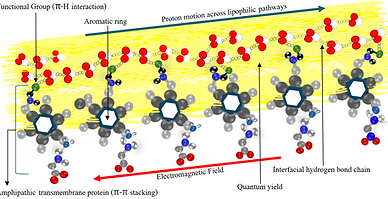Quantum-delocalized information systems in the brain: nonclassical pathways
to the emergence of consciousness
How to Cite This article
R.R. Poznanski, O. Pusuluk and C.H.Raymond Ooi (2025). Quantum-delocalized information systems in the brain: nonclassical pathways to the emergence of consciousness. Journal of Multiscale Neuroscience 4(2), 84-106.
DOI: https://doi.org/10.56280/1699258685

Authors Affiliation
R.R. Poznanski
BION Institute, SI-1000 Ljubljana, Slovenia
O. Pusuluk
Faculty of Engineering and Natural Sciences, Kadir Has University Istanbul 34083, Turkey
C.H.Raymond Ooi
Department of Physics, Universiti Malaya, Kuala Lumpur 50603,
Malaysia
Received 21 March 2025
Accepted 15 May 2025
Online published 3 June 2025
ORIGINAL RESEARCH
Publication: Journal of Multiscale Neuroscience DOI: https://doi.org/10.56280/1699258685
Abstract
This paper presents a theoretical model proposing that quasiparticle-mediated proton (H+) dynamics, modulated by dipolar excitations across π-conjugated organic molecules, specifically at amphipathic membrane proteins and interfaces, give rise to emergent hybrid modes—termed tripartite quasipolaritons—under nonequilibrium steady-state conditions. These modes arise from light-matter-vibration coupling dynamics. Quasiparticle-mediated proton dynamics within the hydrophobic pockets of amphipathic complexes occur through their non-closure under nonequilibrium steady-state conditions. We explore how quantum optical effects facilitate light-matter interactions, enhancing photoprotection, involving vibrational modes when anti-entropic conditions prevail for delocalized π-excitations while maintaining conserved epistemic quantum entropy. Dipolar excitations through patterns of energetic uncertainties play a role in establishing the conditions needed for a unified and interconnected informational system of photon pathways in aromatic amino acid residues. This system is proposed to link localized biochemical processes involving π-H+ interactions and π-π stacking of amino acids in neuroproteins with the coupling dynamics that give rise to quantum optical effects. Quantum-delocalized information systems, involving the interplay between π-electron dynamics, localized electromagnetic fields, and proton interactions, create a quantum bridge between quantum optical effects and quantum memory. This may provide pathways through which intrinsic quantum phenomena, such as quantum memory, directly contribute to consciousness by enabling the action selection mechanism in quantum-delocalized systems. Our model proposes that such systems may underlie consciousness, supported by the quantum architecture of the multiscale brain. This framework uncovers a previously hidden mechanism for the interconnectedness of informational pathways between amino acids in proteins and among neural protein networks within and across neuropil microcavities, revealing a quantum foundation for functional unity.
Keyword: Consciousness, quantum emergent physicalism, quantum proton delocalization, π-conjugated amino acids, π resonance dipoles, amphipathic complexes, microcavity quasipolaritons, epistemic quantum entropy, entropic pilot waves, anti-entropic condition, Madelung hydrodynamics, optical resonance, structure process.
Conflict of Interest
The authors declare no conflict of interest
This article belongs to the Special Issue
Brain Complexity Across Scales: Structural, Functional, and Emergent Aspects of Consciousness
Lead Editor:
Prof. Marco Agostino Deriu
Politecnico di Torino, Department of Mechanical and Aerospace Engineering,
PolitoBioMed Lab, Corso Duca degli Abruzzi 24, Torino, 10129, Italy
Copyright: © 2025 The Author(s). Published by Neural Press.
This is an open access article distributed under the terms and conditions of the CC BY 4.0 license.
Disclaimer: All claims expressed in this article are solely those of the authors and do not necessarily represent those of their affiliated organizations, or those of the publisher, Neural Press™ or the editors, and the reviewers. Any product that may be evaluated in this article, or claim that made by its manufacturer, is not guaranteed or endorsed by the publisher.
References:
Alemdar, E. Poznanski, R.R. Cacha, L.A., Leisman, G. & Brändas, E. J. (2023) New insights into holonomic brain theory: implications for active consciousness. Journal of Multiscale Neuroscience 2, 159-168.
Asano,M., Basieva,I., Khrennikov, A., Ohya, M., Tanaka,Y. & Yamato, I. (2015) Quantum information biology: from information interpretation of quantum mechanics to applications in molecular biology and cognitive psychology. Foundations of Physics 45, 1362-1378.
Baars, B.J. (1993) A Cognitive Theory of Consciousness Cambridge University Press, Cambridge.
Babcock, N.S., Montes-Cabrera, G., Oberhofer, K.E., Chergui, M., Celardo, G.L. & Kurian, P. (2024) Ultraviolet super-radiance from mega-networks of tryptophan in biological architectures. Journal of Physical Chemistry B 128, 4035-4046.
Barchfeld,G.L. & Deamer,D.W. (1985) The effect of general anesthetics on the proton and potassium permeabilities of liposomes. Biochimica et Biophysica Acta 819, 161-169.
Bayne, T. & Chalmers, D. (2003). What is the unity of consciousness? In A. Cleeremans (Ed.), The Unity of Consciousness: Binding, Integration, Dissociation. Oxford: Oxford.
Boeyens, J.C.A. (2000) Quantum potential chemistry. South African Journal of Chemistry 53,49-72.

.png)